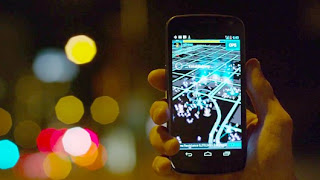Hello!
Happy New Year :).
 |
| From Berg London |
Last month a lot of interesting things showed up on the internet. The first one was lamps, a collaboration between BERG london and google creative labs (which somehow is untraceable on google... ). It started out with the question of what google would be if it were physical and thus not behind glass. The end result is an interesting mix between projection mapping and a DIY kind of Kinect. This "lamp" could project data on the things it sees, which might be handy on a desktop: maybe to do some sort of physical photoshop, aided and saved by a computer or even the cloud!
 |
| Wheathly from Portal 2 |
Anyway, there were some very interesting remarks about what this "lamp" shuld be. They called it a companion species like Bit in Tron or the Daemons in the "His Dark Materials" trilogy by Phillip Pullman. I realy like this concept, now that i think of it it can also be that robot from portal2 Wheatly :). But this lamp would be your little mind (companion) that connects to the big mind, aka the cloud, to help you do your things and give you more and relevant information. (Actually this also sounds like paperclip from word :), but then hopefully more helpful and context aware.)
 |
| From Berg London |
It is interesting how this companion species is described: "... when our digital tools become more than just tools - acquiring their own behaviour, personality and agency." For example Lamp, would be you companion that would shoot between the cloud and the real world. Having learned from experience what you like, how fast you;d like it and how you like your information given, it will adapt itself more and more to you. But that is not the only thing: having its own personality and behaviour means that it is able to surprise you.
It kind of reminds me of what I wanted to create for a project, though a lot less informative. I wanted to create a little creature that would need a lot of attention when you'd want to sleep during a lecture. It would try to move, break free, or even scream, to make sure you'll keep it in check before some social awkwardness appears. But this idea is a lot more interesting in onnovatove in how it looks at the prodict itself, what its function is and how it should interact with the user.
More on this later? maybe? :)
 |
| Ingress |
The other cool thing that showed up is Ingress by Google (coincidence?). Which is a game that wants to break free from the screen. It makes you go outside, see the world and progress in the game. It is connected to the internet so it becomes a sort of mmorpg but then in real live.
I guess it's a mix between existing things: Pac Manhattan, FourSquare (and other geolocation based games) and maybe even WOW, but then mixed into something new and big. The deal is that Google made it and I think that they can make something big out of it so it can become interesting to play. Because, especially with a game like this you'd need to have a lot of players to keep it interesting. I'd like to see how this develops :).
 |
| The Nature of Code |
In the more programming or Creative coding world, two interesting things came up, The Nature of Code by Daniel Shiffman and Weird Faces Study by Matthias Dörfelt created in paper.js. I'm still in the process of reading the nature of code, But so far it is very interesting, and it really helps me a lot in developing my coding skills and the way I think about programming stuff.
 |
| Weird Faces Study |
Weird Faces Study showed me something that I never thought about but really hit me in the face. In this project a computer makes up faces and they are all different, and it seems as though an artist has created them! But the thing is, Matthias created a set of different eyes, noses, ears and so on, and the computer can draw a face with randomly chosen eyes and ears, but still change them a little bit. This is why every face is different.
The thing that was interesting for me was that he uses predefined objects and then shuffles them together! Now that I think about it I've seen it at Spelunky:
 |
| Spelunky |
Which creates whole levels by randomly placing tiles in the level, but also maintaining a playable level.
And Canabalt:
 |
| Canabalt |
Which places building block and other set pieces randomly so that every run is different.
So now I plan to make a program that is both predictable and yet, also, still unpredictable and random!
I hope you have liked the read :).
and see you next time!
Frank

No comments:
Post a Comment